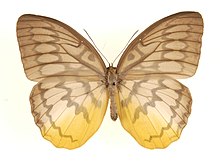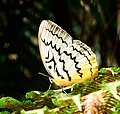
Rainforests are forests characterized by high and continuous rainfall, with annual rainfall in the case of tropical rainforests between 2.5 and 4.5 metres and definitions varying by region for temperate rainforests. The monsoon trough, alternatively known as the intertropical convergence zone, plays a significant role in creating the climatic conditions necessary for the Earth's tropical rainforests: which are distinct from monsoonal areas of seasonal tropical forest.
Highlands or uplands are any mountainous region or elevated mountainous plateau. Generally speaking, upland refers to ranges of hills, typically up to 500–600 m. Highland is usually reserved for ranges of low mountains.
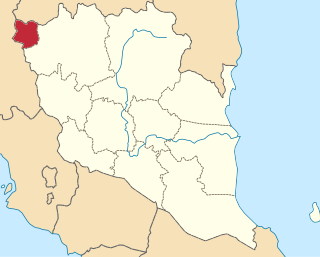
The Cameron Highlands is a district in Pahang, Malaysia occupying an area of 712.18 square kilometres (274.97 sq mi). To the north, its boundary touches that of Kelantan; to the west, it shares part of its border with Perak.

The Wildlife of Costa Rica comprises all naturally occurring animals, fungi and plants that reside in this Central American country. Costa Rica supports an enormous variety of wildlife, due in large part to its geographic position between the North and South American continents, its neotropical climate, and its wide variety of habitats. Costa Rica is home to more than 500,000 species, which represents nearly 5% of the total species estimated worldwide, making Costa Rica one of the 20 countries with the highest biodiversity in the world. Of these 500,000 species, a little more than 300,000 are insects.

Fabriciana adippe, the high brown fritillary, is a large and brightly colored butterfly of the family Nymphalidae, native to Europe and across the Palearctic to Japan. It is known for being Great Britain's most threatened butterfly and is listed as a vulnerable species under the Wildlife and Countryside Act 1981. Like other fritillaries it is dependent on warm climates with violet rich flora.
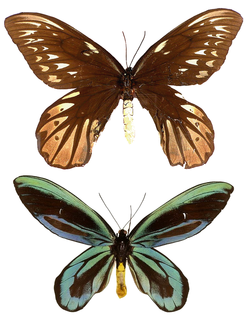
Ornithoptera alexandrae, the Queen Alexandra's birdwing, is the largest species of butterfly in the world, with females reaching wingspans slightly in excess of 25 cm. This birdwing is restricted to the forests of the Oro Province in eastern Papua New Guinea.

Delias eucharis, the common Jezebel, is a medium-sized pierid butterfly found in many areas of south and southeast Asia, especially in the non-arid regions of India, Sri Lanka, Indonesia, Myanmar and Thailand. The common Jezebel is one of the most common of the approximately 225 described species in the genus Delias.

Ornithoptera goliath, the Goliath birdwing, is a birdwing butterfly found in New Guinea. It is the second largest butterfly in the world, after the Queen Alexandra's birdwing.
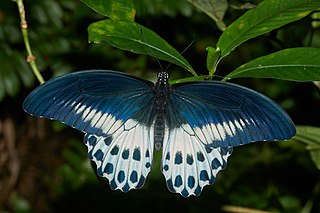
Papilio polymnestor, the blue Mormon, is a large swallowtail butterfly found in south India and Sri Lanka. It is the "state butterfly" of the Indian state of Maharashtra.

Moduza procris, the commander, sometimes included in the genus Limenitis, is a medium-sized, strikingly coloured brush-footed butterfly found in South Asia and Southeast Asia. It is notable for the mode of concealment employed by its caterpillar and the cryptic camouflage of its pupa.
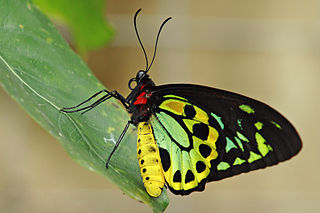
Ornithoptera euphorion, the Cairns birdwing, is a species of birdwing butterfly endemic to north-eastern Australia, and is Australia's largest endemic butterfly species. Other common names include Cooktown birdwing and northern birdwing. The names Cairns and Cooktown in its common name reference the Australian cities in the region where this butterfly is found.
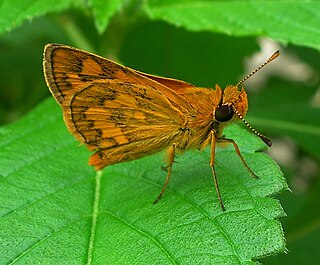
Potanthus is a large genus of skipper butterflies. They are commonly known as darts. They are found from South Asia to East Asia, and down to maritime Southeast Asia. It includes about 35 species, all of which look very similar to each other and are often only reliably identifiable through the examination of the male genitalia.

The pallid cuckoo is a species of cuckoo in the family Cuculidae. It is found in Australia, with some migration to the islands of Timor and Papua New Guinea. It is between 28 and 33 cm in size, with distinctive markings such as a dark bill, a dark eye with a gold eye-ring and olive grey feet which differentiate it from other cuckoos. The pallid cuckoo is similar in appearance to the oriental cuckoo, with barred immature pallid cuckoos being often mistaken for oriental cuckoos.

The Blue-throated bee-eater is a species of bird in the bee-eater family. They are found throughout southeast Asia in subtropical or tropical mangrove forests. Their diet consists mostly of bees, wasps, and dragonflies. Blue-throated bee-eaters are small with colorful plumage consisting of a red nape, dark green wings, light green breast, and their signature blue throat. Juvenile plumage contain dark green head and wings and light green breasts, only developing their full plumage in adulthood. They have a rich variety of songs and calls, including longcalls which allow them to communicate long distances in the forest.

The Malayan whistling thrush or Malaysian whistling-thrush is a species of bird in the family Muscicapidae. It is endemic to the Malay Peninsula. Due primarily to habitat loss, its population is thought to be in decline.

The rose robin is a small passerine bird native to Australia. Like many brightly coloured robins of the Petroicidae, it is sexually dimorphic. The male has a distinctive pink breast. Its upperparts are dark grey with white frons, and its tail black with white tips. The underparts and shoulder are white. The female is an undistinguished grey-brown. The robin has a small black bill and eyes.
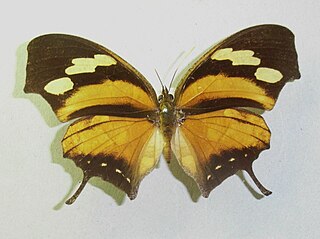
Consul, described by Pieter Cramer in 1776, is a South American nymphalid butterfly genus in the subfamily Charaxinae.

Philaethria dido, the scarce bamboo page or dido longwing, is a butterfly in the family Nymphalidae. It is found in Central America and tropical South America, both east and west of the Andes, from Brazil and Ecuador northwards to Mexico. Strays can sometimes be found in the lower Rio Grande Valley in southern Texas.

Troides amphrysus, the Malay birdwing, is a birdwing butterfly in the genus Troides in the family Papilionidae.

Faradaya splendida is an evergreen vine in the family Lamiaceae which produces white, fragrant flowers and white, egg-shaped fruit. It naturally is occurs in the tropical rain forests of tropical Asia and Australia and is often sighted along rain forest margins such as roads. Some common names include October Glory, Glory Vine, Potato Vine and Fragrant Faradaya. Australian indigenous names for F. splendida include Garanggal used from Cairns to Yarrabah, Buku used in the Tully River area, Koie-yan used at Dunk Island and Djungeen used by the Girramay clan.
